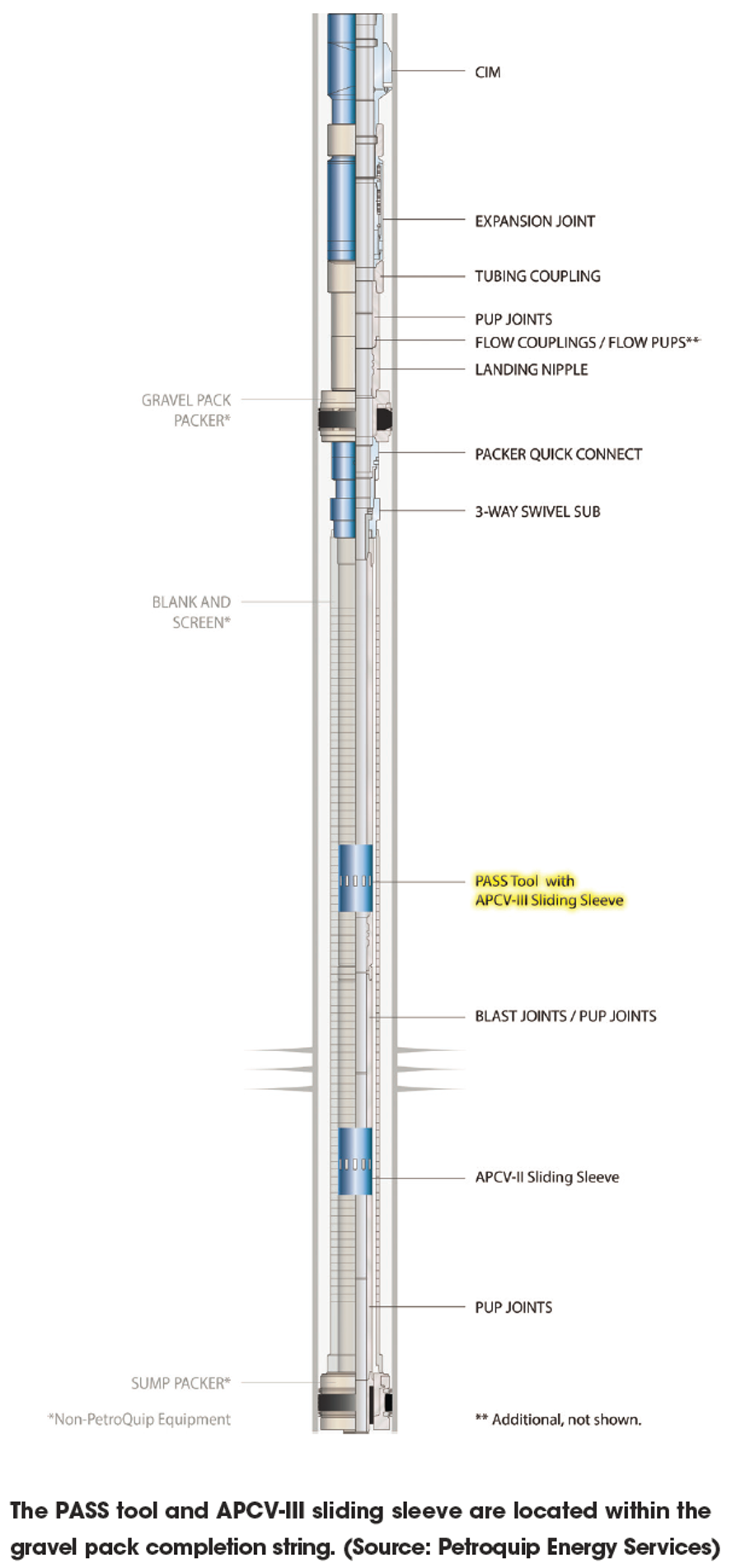
The PASS tool’s pressure-actuated sleeve-shifting design replaces mechanical shifting sleeves. (Source: Petroquip Energy Services)
Operators are drilling and completing more difficult and challenging wells at deeper depths. Those depths, combined with the directional drilling component, add more risk to accomplishing manipulation of flow devices such as sliding sleeves.
Unfortunately, the conventional method of using wireline involves acceptance of the risk of losing tools or wire in the well, and the smart completion method is an expensive option that destroys the profitability of shelf and shallow-water projects. Both methods put operators in a position between a rock and a hard place.
A pressure-actuated sleeve shifting (PASS) tool was designed by Petroquip Energy Services to replace the mechanical shifting sleeves, reducing risk and costs associated with the wireline trips traditionally required to bring the well to production.
One company has benefitted in the past by using the PASS tool in depths more than 1,829 m (6,000 ft). The 27/8-in. PASS tool helped the operator eliminate the costs and risks associated with production, like running wireline into the well after completion and enabling remote operation of the sliding sleeve in highly deviated wells where coiled tubing or a wireline tractor is required to function the mechanical sleeve.
Scenario No. 1
A Walter Oil and Gas Corp. well in Mississippi Canyon Block 583 was drilled as a sidetrack off an existing well to produce the Pliocene H-5 sand. The producing interval was drilled at a 58-degree angle from vertical. Running wireline can be problematic at a well angle as steep as this, so the operator chose to use the tool for zonal isolation and production. Two tools were run in the producing interval. The lower of the two was run in the hole in the open position so that fluid could be returned to the surface during the stimulation phase of the completion.
The Pliocene H-5 sand was located at about 3,322 m (10,900 ft) true vertical depth (TVD) below the mud line and in 758 m (2,487 ft) of water. The formation was perforated using tubing-conveyed perforating (TCP) guns run in hole on drillpipe in 14 parts per gallon (ppg) completion brine. The guns were fired with an underbalance of 500 psi at an interval of 3,318 m to 3,334 m (10,886 ft to 10,939 ft) TVD after about 853 m (2,800 ft) of seawater was circulated in. The bottomhole pressure (BHP) was 7,600 psi with a temperature of 63 C (145 F).
The sand control assembly with the PASS tools was run into the hole. The packers were set, and the stimulation job was completed successfully. Upon pulling the gravel pack assembly out of the hole, the work string shifting tool on the bottom of the work string shifted the lower tool to the closed position and unlocked both tools, making them ready for activation via tubing pressure. The production tubing was then run and the tubing hanger landed. The tools were then later opened by increasing the tubing pressure above the shear pressure of 6,500 psi, then bleeding the tubing pressure to 0 psi. The well was then able to flow so that production testing could be performed.

Scenario No. 2
At a major operator’s Eugene Island Block 238 well, a single zone was completed using a single trip in combination with drillstem testing and sand control tools. An interval of about 23 m (73 ft) was perforated using TCP guns with a hydraulic delay firing head in 10.4 ppg brine; the guns were released from the downhole assembly and dropped into the rathole during the perforating operation. The perforating packer was then unset, screens were placed across the perforated interval and then the sand control packer was set. The sand control operation was a frack pack using crosslinked guar polymer gel (built from 8.6 ppg potassium chloride [KCl] brine) loaded with gravel at a maximum concentration of 10 lb/gal added.
The job was pumped at 20 bbl/min and screened out at about 5,500 psi successfully. Excess gravel was reversed out of the tubing string by reverse-circulating two tubing volumes of 10.4-ppg brine to surface. Once the frack pack operation was finished, the service tool and washpipe were removed, isolating the well via the set sand control packer and the APCV-II sleeve valves within the three-way crossover assembly. The APCV-II sleeve valves were pressure-tested to 500 psi for 10 minutes successfully.
The well was then displaced to 8.7 ppg KCl for the running of the upper completion. The seal assembly, nipple profiles, gas-lift mandrels and safety valve were all run on a 27/8-in. 6.5 lb/ft L80 completion string and landed. The APCV-III sleeve with the PASS tool was then opened for production via applied pressure to the tubing string and then bleeding off as per the Petroquip procedures.
Scenario No. 3
A similar configuration was run in a Eugene Island Block 361 well for a major operator. The well was stimulated as designed, and once completed, a hurricane threatened the Gulf of Mexico operations. The operator elected to remove the rig from location and return at a later date to bring on production. Prior to departing location, pressure was applied down the production tubing and then bled off, shearing the screws and leaving the PASS tool ready for opening. The BHP on this well was low, so by design, the operator planned on using the gas-lift system to lighten the hydrostatic pressure and actuate the tool.
The well was temporarily abandoned, and the rig departed location. The operator did not direct operations to gas-lift the well to achieve the required underbalance for a period of 10 months. For abandoning the well for such a long time period, the operator was pleased that the well remained intact and no leaking/damage had occurred. There was some initial concern that after sitting in the well for this period of time, the functionality of the PASS tool and APCV-III sleeve could be affected due to asphaltene or paraffin buildup.
When directed, operations lightened the fluid column with the gas-lift mandrels, and the PASS tool and the APCV-III sleeve functioned as designed; the well came on production with no issues.
The PASS tool has been in the industry since 2007, and its results have saved operators hundreds of thousands of dollars in potential issues and delayed operations due to the risk associated with wireline intervention.
If such intervention incurred issues, the operator could spend days if not weeks fishing wire and lost tool downhole, preventing commencement of production. This would extend expenses unaccounted for through additional day rates for rigs and personnel as well as the added cost of fishing equipment and services. Earned day rates alone account for $70,000 to $500,000 per day depending on water depth and rig type. At a time where operators must maximize production, the tool is providing a superior risk-averse alternative at a competitive price.
Recommended Reading
Tech Trends: Halliburton’s Carbon Capturing Cement Solution
2024-02-20 - Halliburton’s new CorrosaLock cement solution provides chemical resistance to CO2 and minimizes the impact of cyclic loading on the cement barrier.
Tech Trends: SLB's Autonomous Tech Used for Drilling Operations
2024-02-06 - SLB says autonomous drilling operations increased ROP at a deepwater field offshore Brazil by 60% over the course of a five-well program.
Trio Petroleum to Increase Monterey County Oil Production
2024-04-15 - Trio Petroleum’s HH-1 well in McCool Ranch and the HV-3A well in the Presidents Field collectively produce about 75 bbl/d.
Deepwater Roundup 2024: Offshore Europe, Middle East
2024-04-16 - Part three of Hart Energy’s 2024 Deepwater Roundup takes a look at Europe and the Middle East. Aphrodite, Cyprus’ first offshore project looks to come online in 2027 and Phase 2 of TPAO-operated Sakarya Field looks to come onstream the following year.
Deepwater Roundup 2024: Offshore Australasia, Surrounding Areas
2024-04-09 - Projects in Australia and Asia are progressing in part two of Hart Energy's 2024 Deepwater Roundup. Deepwater projects in Vietnam and Australia look to yield high reserves, while a project offshore Malaysia looks to will be developed by an solar panel powered FPSO.





